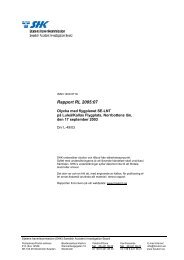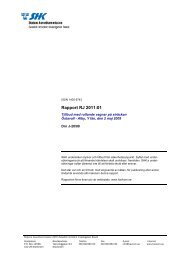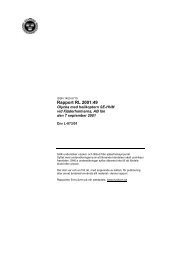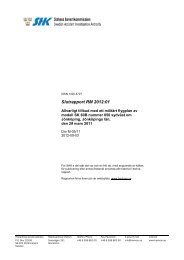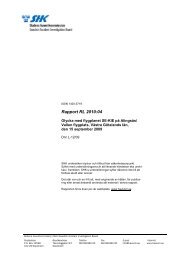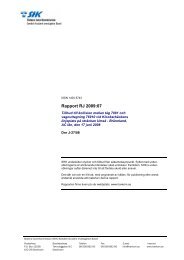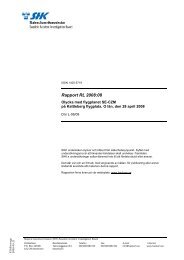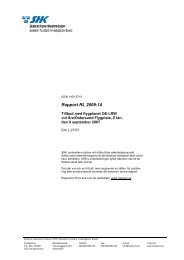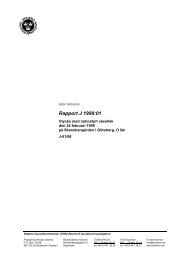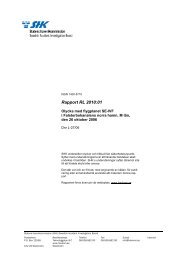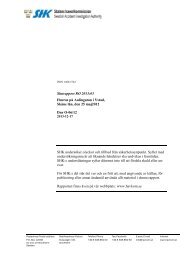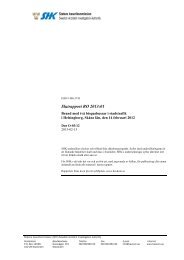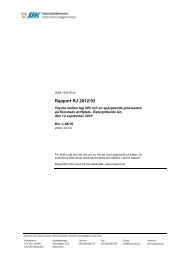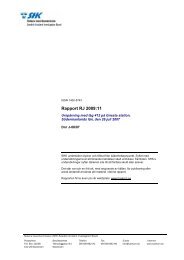Rapport RL 2006:08 - Statens Haverikommission
Rapport RL 2006:08 - Statens Haverikommission
Rapport RL 2006:08 - Statens Haverikommission
Create successful ePaper yourself
Turn your PDF publications into a flip-book with our unique Google optimized e-Paper software.
Driftdata från den aktuella flygningen sändes till motortillverkaren dagenefter händelsen. Ur dessa kunde utläsas att motorstart, taxning ochstart från Säve skedde med normala motorvärden (se bilaga 2). Vid motorpådragetsom avslutade den första nödlandningsövningen kan iakttagasatt motorvarvets ökning inte skedde likformigt utan med svängningar. Därefterstabiliserades motorvarvet på en normal fullgasnivå. Efter en knappminut drogs åter effekten ned och nödlandningsövning två började. Närgasreglaget återigen fördes framåt ökade motorvarvet förbi det normala ochstabiliserades inte förrän motorns eget övervarvsskydd vid omkring 4800motorvarv per minut (rpm) ströp mängden insprutat bränsle.Motortillverkarens bedömning av orsaken till händelseförloppet var attden tidigare nämnda kopplingen troligen slirat.Den tekniska undersökningen utfördes sedan flygplanet bärgats till enlokal på flygplatsen och koncentrerades till motorinstallationen.5På bilden ovan ses svänghjulet och kopplingskorgen sedan växellådanavmonterats.I centrum på kopplingskorgen syns lamellcentrum med ingående axel tillväxellådan. Axeln är förbunden med lamellcentrum via ett bomförband. Detkunde genast konstateras att svänghjulet var blåanlöpt och att nedre delenav svänghjulet var fyllt av damm, se pilen. De sex skruvarna som syns påbilden fäster kopplingskorgen till svänghjulet och var dragna mot kopplingskorgenmen kunde lossas utan att något mätbart moment behövdeanvändas.Lamellen (ovan) visade tecken på överhettning och dess belägg var sågott som helt utslitet.
6Bilden ovan visar kopplingskorgen med tryckplattan överst. Mellan demkan fjäderpaketen ses. Dessa består vardera av ett antal tallriksfjädrar, avpassadeatt ge kopplingen ett slirmoment på 290 Nm.Nedanstående två bilder visar kopplingskorgen med sina åtta fjäderpaketsamt baksidan på tryckplattan. Notera kopplingskorgens sex anliggningsklackarmed hål för monteringsskruvarna.Tryckplattans baksida visade tydliga märken efter fjäderpaketen, menäven en extra uppsättning märken förmodligen från en tidigare montering.Varje fjäderpaket består av 12-13 tallriksfjädrar monterade i en tvådeladhållare. Se bild på nästa sida.
7Tallriksfjädrar eller Belleville washers är kupade, härdade stålbrickorsom används som fjädrar i många applikationer. De karaktäriseras av storfjäderkraft för en liten fjädringsrörelse. Flera tallriksfjädrar kan monterasantingen i serie eller parallellt. Vid seriemontering adderas fjädringsrörelsen,och om man parallellmonterar dem adderas kraften. På grund av friktionenmellan parallellmonterade tallriksfjädrar har dessa en påtaglig hysteres,dvs. fjäderkraften är betydligt högre vid ökande belastning än vidminskande.I den aktuella kopplingen monteras tallriksfjädrarna omväxlande parallelltoch i serie. Bilderna nedan visar tre parallella tallriksfjädrar och treseriemonterade, samt hur monteringsordningen 3-3-3-2-1 och 3-3-3-2-2 äruppbyggda. Enligt fabrikens underlag ska tallriksfjädrarna monteras 3-3-3-2-2. Muntligt har även monteringsordningen 3-3-3-2-1 nämnts.Den senare monteringsordningen hade också tillämpats på den aktuellakopplingen.För att kopplingen enligt vad som sagts tidigare ska slira vid ett momentav ca 290 Nm krävs att fjäderpaketen vid monteringen av kopplingskorgenkomprimeras till rätt höjd och därmed rätt förspänning. Detta åstadkomsgenom att distansbrickor läggs under fjäderpaketen. Distansbrickorna tillverkasmed tjocklek från 2.20 till 3.20 mm i steg om 0.05 mm. Slirmomentetprovas sedan med en momentnyckel. Enligt fabrikens monteringsföreskriftAFO <strong>08</strong>-40 kan fjädrarnas monteringsordning ändras eller distansbrickornabytas tills rätt momentvärde uppnås.De sex skruvar som fäster tryckplattan till svänghjulet ska ha ett åtdragningsmomentav 25 Nm. För att skruvarna inte ska vibrera loss är de låstamed låsvätska, Loctite 243. Låsvätskan är en dimetakrylatester som härdar
i frånvaro av luft. Styrkan hos låsningen kan variera och är beroende avflera faktorer såsom renheten hos de delar som ska låsas, och vilka materialsom ingår. Till exempel är låsningens styrka på rostfritt stål endast ca 25 %av styrkan på kolstål. Därtill minskar styrkan med stigande temperatur, såatt vid 100 °C återstår knappt 50 % av styrkan vid rumstemperatur.Det aktuella svänghjulet är tillverkat av 1.7225-stål, ett härdbart rostfrittstål med goda hållfasthetsegenskaper.8Närbild av svänghjulet och ett av kopplingskorgens skruvhål. I hålet kanses rester av härdad låsvätska. Notera att blåanlöpningen som uppstod närkopplingen slirade och överhettades nästan helt saknas runt hålet där kopplingskorgensklack haft kontakt med svänghjulet. På bilden kan även skönjasen ”linje” som skär bulthålet. Detta är i verkligheten en skillnad i nivå,så att kopplingskorgens klack har haft fullständig anliggning mot svänghjuletendast på den yttre delen, den del där blåanlöpningen saknas. SHK harstuderat enstaka andra svänghjul och funnit att denna nivåskillnad inte ärenhetlig utan kan variera i storlek.Kopplingen sändes till motortillverkaren för vidare undersökning. <strong>Rapport</strong>enåterfinns som bilaga 2.I rapporten konstateras bl. a. att kopplingslamellen var helt nedsliten,att inget tydde på att olja kommit in i kopplingshuset, samt att ett flertal avtallriksfjädrarna var permanent tillplattade, vilket tyder på att temperatureni fjäderpaketen varit högre än ca 130 °C. Motortillverkaren redovisaräven prov som gjorts för att klarlägga sambandet mellan skruvarnas åtdragningsmomentoch kopplingens slirmoment. Enligt dessa prover krävsett åtdragningsmoment högre än ca 12 Nm för att kopplingen ska kunnaöverföra avsett moment, ca 280 Nm. Teoretiskt och utan friktion krävs endastett åtdragningsmoment på ca 1.6 Nm per skruv för att spänna fjäderpaketenså att tryckplattans klackar ligger an mot svänghjulet.Man har även monterat samman flera nya kopplingar med samma monteringsordningpå tallriksfjädrarna och samma distanser under fjäderpaketenoch därvid noterat ett slirmoment på ca 140 Nm.Tillverkarens slutsats angående orsaken till att kopplingen slirat är attantingen:1. har skruvarna inte varit åtdragna med föreskrivet moment, eller2. har teknikern som monterade kopplingen på SE-LTF av någon anledningarrangerat om tallriksfjädrarna, eller har3. svänghjulet inte bytts utan det ursprungliga har fått sitta kvar ochdärmed omintetgjort slirmomentinställningen.
Särskilda undersökningarTallriksfjädrarnaTallriksfjädrar har funnits på marknaden sedan 1800-talets mitt. Dimensionstabelleroch dimensioneringsunderlag är numera lätt att skaffa viaInternet. Med hjälp av dessa underlag kan överslagsberäkningar göras föratt få en klarare bild av hur fjädrarna fungerar i den aktuella installationen.Ingångsvärden:Friktionsbeläggets medelradie är 78.5 mm.Friktionskoefficient µ antages vara 0.5.Med gängse beräkningsmetoder ger dessa värden ett behov av en normalkraftpå kopplingslamellen av ca 7390 N vid momentet 290 Nm. Uppdelatpå åtta fjäderpaket ger det ca 924 N/paket.De enskilda tallriksfjädrarna förefaller vara i enlighet med DIN 2093, typD147205, dvs. D=14, d=7.2 och t=0.5 mm. Total höjd inkl. materialtjocklek=0.9mm. Fjädrarna kan alltså fjädra maximalt 0.4 mm innan de bottnaroch blir platta. Observera att fjädrarna normalt inte tar skada av att statiskttillplattas.Enligt vad som tidigare framgått var fjädrarna anordnade 3-3-3-2-1, vilketkan illustreras antingen >>> )delas kraften av fjädrarna så att var och en upptar 924/3 = 3<strong>08</strong> N. I undergruppernamed två fjädrar ( >> ) delas 924 N på två och var fjäder upptarsåledes 462 N. Den ensamma fjädern ( > ) tar hela kraften 924 N.De flesta tallriksfjädrar har ett relativt rätlinjigt förhållande mellan belastningoch hoptryckning och litteraturen anvisar beräkningssätt som ärtillförlitliga upp till en sammantryckning av ca 75 % av den maximala. Vidsammantryckning över 75 % blir fjädern alltmer progressiv och fjäderkraftenökar mycket hastigt med sammantryckningen. Det bör noteras att dettaäven medför att kraften minskar mycket hastigt vid minskad sammantryckning.Se nedanstående diagram.9De krafter som tidigare framräknats motsvarar enligt nämnda beräkningssätten sammantryckning av fjädrarna som parallellmonterats tre ochtre på ca 0.35 mm, dvs. 87 % av maximal sammantryckning. Sammantryckningenav de övriga fjädrarna är 100 %, dvs. de är helt plana.
SammanfattningDen valda monteringsordningen innebär att flera fjädrar i fjäderpaketen vidsammansättningen av kopplingen trycks samman helt och blir platta, vilketmedför att fjäderkraften minskar mycket hastigt vid minskad sammantryckning,i det här fallet vid kopplingslamellens slitage.KopplingslamellenDen 13 juni 2005, alltså fyra månader efter den aktuella händelsen utgavmotortillverkaren en servicebulletin, TAE125-0011 rev 3. I denna bulletinanges att 105 kopplingar, däribland den här aktuella, ska återsändas tillfabriken för att bytas ut. Orsaken till detta anges inte i bulletinen, men SHKhar via korrespondens med tillverkaren fått informationen att dessakopplingar efter översyn har levererats med begagnade lameller. Dessa begagnadelameller har varit inom tjocklekstoleransen för nya lameller, mentrots det har några av dem slirat.Efter detta och den aktuella händelsen har kopplingslamellens egenskaperstuderats av motortillverkaren. Vid dessa studier som genomförts tillsammansmed tillverkaren av kopplingslamellen har framkommit att kopplingensslirmoment som vid monteringen sätts till ca 290 Nm, under deförsta ca 50 driftstillfällena (cycles) ökar till ca 410 Nm. Detta förklaras medatt lamellens friktionsbelägg under denna inkörningsperiod bildar ett ytskiktsom verkar höjande på friktionsvärdet. De återanvända kopplingslamellersom slirat har samtliga före leverans från motortillverkaren rengjortsvarvid det bildade ytskiktet tvättats bort. Prov som gjorts med tvättade lamellervisar att efter en tvättning ökar slirmomentet som mest till ca 390Nm och efter två tvättar till som mest ca 340 Nm efter 120 cycles men medett någorlunda stabilt värde på ca 300 Nm mellan 25 och 110 cycles.SHK har varit närvarande vid ett planerat kopplingsbyte på en annanflygplansindivid och då noterat att den nya kopplingslamellens tjocklek varca 0.18 mm större än den som skulle bytas ut efter att ha varit i drift i ca300 timmar.Motorns olikformighetAlla kolvmotorer kännetecknas av att det vridmoment som levereras frånvevaxeln pulserar i takt med explosionerna i förbränningsrummet. Denaktuella motorn, en fyrcylindrig fyrtakts dieselmotor, lämnar två kraftpulserper vevaxelvarv. Dessa kraftpulsers storlek tillsammans med det drivnaföremålets, i detta fall propellerns tröghetsmoment avgör hur mycket transmissionenbelastas utöver motorns angivna maximala vridmoment som kansägas utgöra ett medelvärde.I den aktuella installationen finns sex fjäderpaket installerade tangentiellti kopplingslamellens centrum för att isolera propellern och växellådanfrån dessa variationer i vridmomentet.10UtlåtandeDen tekniska undersökningen av flygplanets motorinstallation och analysenav motordata visar att orsaken till effektförlusten är att kopplingen slirat.Orsaken till detta har inte kunnat fastslås med säkerhet.Det kan varken uteslutas att teknikern som monterade kopplingen påSE-LTF av okänd anledning arrangerade om tallriksfjädrarna, att han intebytte svänghjulet, eller att han inte drog skruvarna med rätt moment.SHK har samtalat med berörd tekniker men finner inget av alternativensannolikt.Som tidigare nämnts har fabriken provmonterat flera kopplingar medmonteringsordningen 3-3-3-2-1 och i samtliga fall noterat ett slirmomentpå 140 Nm. Eftersom detta moment bara är ca 57 % av vad motorn maxi-
malt kan lämna är det inte troligt att SE-LTP över huvud taget kommit uppi luften om den aktuella kopplingen haft ett liknande slirmoment, än mindreflugit ca 25 timmar utan anmärkning.Det faktum att återanvända kopplingslameller slirat trots att de av alltatt döma haft ett slirmoment högre än 290 Nm kan tolkas så att en ny lamellinställd på 290 Nm slirar inte bara vid start och stopp under de förstamotorkörningarna. Istället tas en del av vridmomentpulserna under driftupp genom att kopplingen slirar en aning, men att ett slitskikt snabbt byggsupp och inverkar höjande på friktionsvärdet.En återanvänd lamell bygger inte upp något slitskikt, därmed kommerden att fortsätta slira under drift. Lamellen blir då på kort tid så tunn attkraften från tallriksfjädrarna minskar varvid kopplingen slirar kontinuerligtoch havererar.SHK finner att kopplingens utformning innehåller flera tveksamheter.1. Momentdragningen av kopplingskorgens fästskruvar.Enligt tillverkarens egna undersökningar krävs ca 7.5 gånger högre åtdragningsmomentän vad SHK framräknat som teoretiskt värde för att förspännafjäderpaketen. Detta tyder på att det kan vara avsevärd friktion i gänganoch/eller att kopplingskorgen inte har korrekt kontakt med svänghjulet.Den tidigare nämnda nivåskillnaden på svänghjulet kan tyda på det senare.2. Låsningen av kopplingskorgens fästskruvar.Låsvätska är en snabb och billig metod att låsa skruvar så att de inte lossnarpga. vibrationer. Låsvätskor har dock flera nackdelar som tidigare redovisats,och det förefaller som om flera av de ogynnsamma faktorerna varit förhanden i detta fall.3. Dimensioneringen av tallriksfjädrarna.Att seriemontera fjädergrupper med olika antal parallella fjädrar medför attsammantryckningen blir proportionell mot antalet fjädrar i gruppen. I detaktuella fallet medför det att fjädrarna som parallellmonterats färre än treoch tre blir helt plana, något som styrks av att många av fjädrarna efterhändelsen var permanent tillplattade. Om så är fallet är det sannolikt att detallriksfjädrar som är platta i hög grad minskar i förspänning varvid riskenför slirning i kopplingen ökar. Har förspänningen minskat så mycket attkopplingen slirar inte bara vid start och stopp utan även i drift accelererartroligen förloppet och kopplingen havererar efter kort tid.Sammanfattningsvis ser SHK följande svagheter i den aktuella kopplingenskonstruktion och monteringsunderlag.• En säker låsning för kopplingskorgens fästskruvar saknas. Att låsamed låsvätska kan inte anses vara tillförlitligt i den aktuella miljön.• Monteringsinstruktionen saknar föreskrift om att fästskruvarna skamomentdras med smorda gängor. Detta kan medföra att förspänningeni skruvarna varierar trots korrekt åtdragningsmoment.• Nivåskillnaden på svänghjulet medför att det inte går att säkerställaatt kopplingskorgen blir korrekt monterad.• Monteringsordningen för tallriksfjädrarna medför att mer än 75 %av fjädringsvägen hos några av tallriksfjädrarna utnyttjas, vilket kanorsaka att fjäderkraften snabbt minskar när kopplingslamellen slits.• Enligt monteringsanvisningen kan tallriksfjädrarnas monteringsordningändras fritt av montören så länge korrekt slirmoment uppnås.Detta kan leda till att olika kopplingar får olika egenskaper närkopplingslamellen minskar i tjocklek vartefter den slits.11
12Olyckan orsakades av att en återanvänd kopplingslamell var monteradsamt ett flertal brister i kopplingens konstruktion och monteringsunderlag.RekommendationerLuftfartsstyrelsen och EASA rekommenderas att:• verka för att kopplingens utförande och monteringsunderlag ändrasså att ovannämnda svagheter åtgärdas (<strong>RL</strong> <strong>2006</strong>:<strong>08</strong> R1).
OccurrenceinvestigationSE-LTFProject:Document No.:Issue No.:Issue Date:Sheet:Contents:Centurion 1.7OIR-02-01-15-02-2005229.04.2005116SE-LTFLoss of power eventFebruary 17, 2005Status: closedSummaryThe occurrence is related to clutch failure. Since this clutch was checked twice before it left thecompany it assumed that the failure was caused by maintenance.There are two possibilities:First possibility: The clutch could have fallen down and the maintenance mechanic rearranged thespring plate layer arrangement according to the clutch he exchanged.Second possibility: The flywheel mass was not exchanged during the clutch exchange. The frictiontorque is a result of the displacement of the disk springs which is adjusted in the assembly. As soon asone part related to the displacement is exchanged the adjustment must be renewed. This is also thefact if the clutch cage is fitted to the old flywheel.Prepared by:E. BollenChecked by:Approved:
OccurrenceinvestigationSE-LTFProject:Document No.:Issue No.:Issue Date:Sheet:Contents:Centurion 1.7OIR-02-01-15-02-2005229.04.20053161 IntroductionOn February 15 th , 2005 a DA40 D with TAE 125-01 engine installed had a loss of power during atraining flight in Sweden. The aircraft was exercising emergency landings. The two POB wereunharmed. The aircraft damage is described in the Diamond investigation report IR-DA4-0432 Facts2.1 Pilots reportReport emergency landing Diamond DA40 TDI S/N D4.007 SE-LTF, Engine S/N 0063.”Yesterday 15 th of February at 16.30. A teacher and his student were practicing emergency landings.At the second simulated motorstop the power were set to idle at 1000 ft. At 700 ft the teacher set thepower to maximum again intending to climb. The engine did accelerate 100% but they could not feelthe power and was not able to climb or keep thealtitude. The teacher decided to make an emergency landing for real. The aircraft were landing on afield, the two onboard were unharmed.The RH main landing legs and nose leg and propeller was broken.Diamond Aircraft Scandinavia, Öst-Flyg AB, Hans Nilsson“2.2 Initial inspection2.2.1 Airplane Data:Type:DA 40 DSerial-No.: D4.007Year of Manufacture: 2003Call Sign:SE-LTFEngine Type: Thielert TAE 125-01Serial-No.: 0063Propeller Type: MTV-6-A/187-129Serial-No.:n.e.2.2.2 FADEC DataThe Event log:FADEC-A Events in chronological order:2005-01-20 13:55:45 - Info only: Warnings cleared2005-02-15 16:36:54 - Info only: High RPM: up to 4758 rpm for 8,4 seconds2005-02-15 16:37:06 - Info only: High RPM: up to 4759 rpm for 10,0 seconds2005-02-15 16:37:42 - Info only: High RPM: up to 4886 rpm for 45,9 seconds2005-02-15 16:37:55 - Info only: High RPM: up to 4935 rpm for 2,0 secondsThe complete eventlog can be found in Appendix 5.12.2.3 History and maintenance programBased on the maintenance parts, which were ordered at TAE, the clutch of the aircraft was exchangedshortly before the occurrence. According to the Diamond investigation report IR-DA4-043 the clutchwas installed for less than 20 hours of operation.
OccurrenceinvestigationSE-LTFProject:Document No.:Issue No.:Issue Date:Sheet:Contents:Centurion 1.7OIR-02-01-15-02-2005229.04.20054162.2.4 Initial tear down inspectionThe initial tear down inspection was carried through on 22.02.05 in Götenborg by DAI and TAE withthe following attendants:Mr. AkermanSwedish Accident Investigation BoardMr. ÖstlundAirworthiness Inspector, Aviation Safety Department of SwedenMr. AxelssonCAA SwedenMr. MikoschThielert Aircraft EnginesMr. NilssonDAI ScandinaviaMr. StrömanFlight schoolMr. ErikssonMechanicIn this tear down it was detected that the screws of the clutch were not tightened with the requiredtorque according Repair Manual RM-02-01.Extracts of the Diamond investigation report IR-DA4-043:Before removing the gearbox the oil level of the gear was checked. It was enough oil inside. Noleakage of the gearbox was found. After removing the gearbox the clutch was found as follows:11The metal of the clutch cage, the screws to fit the clutch cage, the flywheel mass disk and flywheelmass have different colours (yellow, blue and gray) as a result of thermal load. The zinc coating of thescrews to fit the clutch cage was flaking off as a result of the high temperatures. Inside of the flywheelmass grouted (sintered) metal dust near the positions of the screws (1) was accumulated. Allcomponents were dry, no oil was found on the surfaces.
OccurrenceinvestigationSE-LTFProject:Document No.:Issue No.:Issue Date:Sheet:Contents:Centurion 1.7OIR-02-01-15-02-2005229.04.2005516It was found that the torque of the screws that fit the clutch cage was less than 8 NM.However all screws were tightened so far that the clutch cage seemed to have contact to the flywheelmass. This could be seen on the pressure points of the clutch cage on the fly wheel (2).Unlike stated in the Diamond Investigation Report, the tightening torque of the screws that fit theclutch cage has influence to the friction torque of the clutch.222222At the screws that fit the clutch cage could be recognized traces of Loctite rests that looked blue andblack, located at the base of the thread.
OccurrenceinvestigationSE-LTFProject:Document No.:Issue No.:Issue Date:Sheet:Contents:Centurion 1.7OIR-02-01-15-02-2005229.04.200561634On the back side of the flywheel mass disk were found 16 marks of the spring packages that push theflywheel mass disk against the friction plate. 8 of them from the actual installation (3), 8 of them withred-brown traces of corrosion (4).The clutch was installed only one time, and for less than 20 hours of operation, so the corrosion markscan only be from a previous installation, before this clutch was delivered from Thielert to Sweden.The pressure plate showed gray colour as a result of the high temperatures (> 500°C) in the clutch.The friction plate had no friction lining left, the thickness on the measured pointof the plate was 1.83 mm. It also showed evidence of the thermal load.
OccurrenceinvestigationSE-LTFProject:Document No.:Issue No.:Issue Date:Sheet:Contents:Centurion 1.7OIR-02-01-15-02-2005229.04.20057163 Analysis3.1 Analysis of the FADEC dataThe FADEC Logger data were downloaded on the 17 th of February 2005. The engine was started at16:14 hour (local time). The run up check was carried out successfully. Graph 1 showsthe take off at16.25 hour. All parameters were within the limits at that point of time.Graph 1: Motor 02-01-04<strong>08</strong>-SL01-104-0063, Start of the flight, Take OffAfter Take-off, the aircraft climbed and began with idle decent stages. Graph 2 shows the first and thesecond full power stage. The aircraft descended with idle power setting at second 25 of graph 2. Afterthat stage, the pilot put the throttle lever to 100 %. During this acceleration, the engine was runningwith an engine speed up to 4077 (2410 Prop RPM). In the next second, the engine speed broke downto 3300 RPM. This breakdown is probably caused by the propeller regulator. As soon as a high enginespeed is detected, the propeller control system starts with reducing the propeller speed by changingthe pitch angle. Graph 3 shows a zoom-in of the first acceleration.The increase (Revs above 3900 engine RPM) can be caused by a slipping clutch.After the decent the pilot moved the throttle back to 100%. The “zoom-in” of this acceleration isvisualised in graph 4. During the acceleration the engine is running at very high engine speeds up to4780 engine RPM (2830 Prop RPM). At this point the RPM limiter is liming the power by reducing theinjection volume to avoid further overspeed. The RPM limiter of the FADEC of the engine generallyreduces the injection volume based on the actual RPM. The higher the engine speed is, the less fuelis injected.The data shows a very high engine speed of approximately 4780 engine RPM, the remaining injectionvolume is 20% of the total desired injection volume at full power. The power reduction due tooverspeed is not indicated in the CED instrument. The FADEC Software Version 2,7 will have thisfunction integrated. During overspeed stages, the power reduction caused by the overspeed will thenbe indicated.
OccurrenceinvestigationSE-LTFProject:Document No.:Issue No.:Issue Date:Sheet:Contents:Centurion 1.7OIR-02-01-15-02-2005229.04.2005816This overspeed behaviour of the engine is caused by a problem with the clutch. At the point where thepower increases (and the load on the clutch increases, the clutch starts slipping. The speed at thepropeller will be less than the engine speed divided by the gearbox ratio. The propeller control willpush the propeller from low to high pitch.Graph 2: Motor 02-01-04<strong>08</strong>-SL01-104-0063, Start of the flight, Take Off
OccurrenceinvestigationSE-LTFProject:Document No.:Issue No.:Issue Date:Sheet:Contents:Centurion 1.7OIR-02-01-15-02-2005229.04.2005916Graph 3: 02-01-04<strong>08</strong>-SL01-104-0063, Small high reving of the engine during the acceleration stageGraph 4: Motor 02-01-04<strong>08</strong>-SL01-104-0063, high engine RPMs, up to the RPM-Limiter
OccurrenceinvestigationSE-LTFProject:Document No.:Issue No.:Issue Date:Sheet:Contents:Centurion 1.7OIR-02-01-15-02-2005229.04.200510163.2 Analysis of the clutch3.2.1 History of the affected clutchThe clutch was initially assembled with the engine 02-01-0311-SL01-004-0153 and deliveredin March 2004. After 290 operating hours reached in November 2004, the clutch wasexchanged and sent back to TAE for scheduled 300h-inspection.In this inspection all springs, both driven plate and the friction disk (Assembly, Contact plate)were exchanged.The clutch was inspected by the mechanic after assembly and by the inspector beforedelivery. Measuring equipment used is calibrated until November 2005. A recalibration checkshowed no deviations.The clutch was delivered with a time since new of 304 hours on January 11 th with Form OneIP2162/2005.In conclusion the overall run time of the clutch was approximately 324 hours, except partsexchanged in the 300h inspection.3.2.2 Visual inspection of the affected clutchResults of the visual inspection at TAE facility:The friction pad of the friction disk (Assembly, Contact plate) is worn out totally down to theblank disk. This disk is colored dark blue to black. Partially, there are thin remains of thefriction pad.The torsional damper of the friction disk (Assembly, Contact plate) is undamaged and showsno signs of wear and tear.The flywheel mass is colored blue due to heat influence. Due to the color the temperaturemust have been approximately 300°C. There is a large amount of settled dust on the flywheelmass, especially accumulated at the screws. There are no visual impurities due to othermaterials or other substances like oil.Apart from the mentioned dust the clutch is clean.The disk springs are also colored due to heat influence. Furthermore, many of these springsare completely flat like a washer and have no spring characteristic any more. The layeredarrangement of all disk spring packages were similar 3-3-3-2-1.The driven plate is colored as well. The pressure distribution plate, the flywheel mass and thefriction disk (Assembly, Contact plate) show significant grooves.The screws which fit the clutch against the flywheel mass show no signs of lengthening eitherto thermal or mechanical load.3.2.3 Conclusions based on the visual inspection of the clutchThe clutch must have slipped for a longer time. The friction pad of the friction disk (Assembly,Contact plate) is totally destroyed due to heat influence caused by the slipping.Since there are no signs of fluids like oil found in the clutch or at parts of the clutch, theslipping seemed not to be caused by oil. Otherwise there would have been signs of coked oil.Above temperatures of 130°C the disk springs loose their spring characteristics and becomeflat.The layered arrangement of the disk springs vary from clutch to clutch due to the tolerances ofthe single parts. In the assembly process the layered arrangement is selected in regard to theactual dimensions. The passing criteria is the friction torque, which has to be above 280Nm.
OccurrenceinvestigationSE-LTFProject:Document No.:Issue No.:Issue Date:Sheet:Contents:Centurion 1.7OIR-02-01-15-02-2005229.04.200511163.2.4 Special tests of the clutch to isolate the root cause of failureSince this is the first occurrence related to a slipping clutch in more than 60.000 hours fleetoperation, TAE carried out several tests to identify the root cause for this occurrence.In the first test the friction torque was measured in relation to the tightening torque of thescrews, which fits the clutch to flywheel mass. According to assembly instructions as well asregarding to the repair manual the tightening torque of these screws must be 25 Nm. Thefriction torque has to be between 280 and 290 Nm. The test was performed with a new clutchand confirmed with an inspected clutch.There are the following results:Tightening Torque Friction torque25 Nm 280 Nm15 Nm 280 Nm10 Nm 270 Nm8 Nm 210 Nm5 Nm 180 NmTightenend by hand160 NmFriction Torque [Nm]300280260240220200180160140120100Friction Torque vs Tightening Torque0 5 10 15 20 25 30Tightening Torque [Nm]In conclusion, the test shows that the friction torque is depending on the tightening torque.Since the clutch left company checked by the mechanic and the inspector, it is assured thatthe friction torque was correct at the time of delivery. A further test was performed to getinformation if the spring plate layered arrangement found was acceptable before theoccurrence. Therefore the friction disk (Assembly, Contact plate) and all disk springs of theaffected clutch were exchanged by new parts. The disk spring layered arrangement wassimilar to the affected clutch layered; 3-3-3-2-1. This test was performed with 5 differentfriction disk (Assembly, Contact plate) to assure to be representative. The friction torque foundat 25Nm tightening torque was 140 Nm. A visual comparison of the flywheel mass of theaffected clutch with the flywheel mass which was installed in that aircraft before showed nosignificant deviations.In the next test we exchanged the driven plate of the affected clutch against a new part. Thistest has been also performed with 5 different sets of pressure distribution plates. Also in thiscase, the friction torque found at 25Nm tightening torque was 140 Nm. So, deviations due towear and tear of the driven plate could not be detected.
OccurrenceinvestigationSE-LTFProject:Document No.:Issue No.:Issue Date:Sheet:Contents:Centurion 1.7OIR-02-01-15-02-2005229.04.20051216For a tightening torque of 25Nm the screw has a pretensioning force of 19,3 kN. Due to plasticdeformation after assembly there is a loss of 2,3kN. Under the same conditions a screwtightened with 8Nm has a pretensioning force of 6,2KNA loss in pretensioning force of approximately 11 KN due to plastic deformation is extremelyimprobable.3.2.5 Influence of the surface roughness and its potential effectsThe specified surface roughness (average roughness height Rz) of the flywheel mass is Rz16, which means that in an average of 5 measurements there is a difference of 16µm betweenthe deepest and the highest point of the measuring distance. Experience of the productionshowed, that the Rz value reached for the flywheel mass by turning is less than 10 (equivalent10µm).However, according the VDI (German Engineer Association) Guidance 2230 an embedding of1µm is assumed for a decrease in surface roughness from Rz 40 down to Rz 10, which is adecrease of 30µm average roughness height.In comparison to the difference from the actual Rz value to a grinded surface with a typical Rzvalue of 0,4 the embedding is assumed to be less than 0,35µm.A loss in pretensioning force of approximately 11 KN due to an embedding of 1µm isextremely improbable.
OccurrenceinvestigationSE-LTFProject:Document No.:Issue No.:Issue Date:Sheet:Contents:Centurion 1.7OIR-02-01-15-02-2005229.04.200513164 ConclusionBased on the FADEC data and the inspections, the loss of power was caused by the clutch.The engine delivers a torque of 245Nm at max take-off power. The clutch is designed to dampovertorque of 35-40Nm, which occur during engine starting and turning-off the engine. If the torquewhere the clutch starts slipping is below the engine torque, the clutch slips and gets hot. The wear andtear increases.According to the maintenance schedule, a new clutch was mounted on the aircraft short before theincident occured. In the tear down inspection at Göteborg-Säve the technician found a break awaytorque of less than 8Nm at all screws, which fits the clutch to the flywheel mass. The screws show nosigns of lengthening either to thermal or mechanical load. This is a sign that the screws were nottightened with the specified torque. On the other hand the flywheel mass shows corrosion markswhere the clutch cage usually fits. This is a sign that there was a connection between both theflywheel mass and the clutch cage. However, there is still the possibility that there was a small gap,because corrosion only occurs in contact with air.The surface roughness of the flywheel mass is specified as R z =16, which means 16µm betweenhighest and lowest surface point. Due to the production process a R z value of 10 is reached,equivalent 10µm. The embedding for these class of surface roughness is assumed with less than1µm. The loss in pretensioning force with 11kN is too high to be related to an embedding of 1µm.Further tests have shown, that the specified friction torque can not be reached with the disk springslayered arrangement which was found in the affected clutch. For that test all parts except the clutchcage, the distance plates and the flywheel mass have been replaced by new ones.Since this clutch was checked after assembly by the mechanic and before delivery by the inspector itis improbable that the friction torque was below 280 Nm at the time of delivery.For this deviation there are at least two possibilities which could not be checked by TAE.First possibility: The clutch could has fallen down and the maintenance mechanic rearranged thespring plate layered arrangement according to the clutch he exchanged.Second possibility: The flywheel mass was not exchanged during the clutch exchange. The frictiontorque is a result of the displacement of the disk springs which is adjusted in the assembly. As soon asone part related to the displacement will be exchanged the adjustment have to be renewed. This isalso the fact if the clutch cage is fitted to the old flywheel.
OccurrenceinvestigationSE-LTFProject:Document No.:Issue No.:Issue Date:Sheet:Contents:Centurion 1.7OIR-02-01-15-02-2005229.04.200514165 Attachments5.1 EventlogFADECDATA#18031af102bd207b3eb40fdd#Event Log read 2005-02-17 13:32:34 from FADEC #1068FADEC-A Events in chronological order:2004-<strong>08</strong>-17 10:58:02 - Info only: Warnings cleared2004-<strong>08</strong>-17 10:58:23 - Info only: Warnings cleared2004-09-02 17:44:14 - Info only: Injector shorted: #12004-09-02 17:44:14 - Info only: InjectorPower0 shorted2004-09-23 18:34:55 - Info only: Injector shorted: #12004-09-23 18:34:55 - Info only: InjectorPower0 shorted2005-01-18 12:45:18 - Info only: ECU switchover due to RPM [9]2005-01-18 12:46:14 - Info only: ECU switchover due to RPM [9]2005-01-18 12:47:58 - Info only: ECU switchover due to RPM [9]2005-01-19 10:34:00 - Info only: Warnings cleared2005-01-19 11:23:33 - Info only: ECU switchover due to RPM [9]2005-01-19 11:31:36 - Info only: Warnings cleared2005-01-19 11:54:41 - Info only: ECU switchover due to RPM [9]2005-01-19 12:03:42 - Info only: Warnings cleared2005-01-19 12:04:47 - Info only: Warnings cleared2005-01-19 12:05:28 - Info only: ECU switchover due to RPM [9]2005-01-19 12:07:28 - Info only: ECU switchover due to RPM [9]2005-01-19 12:<strong>08</strong>:58 - Info only: Warnings cleared2005-01-19 12:09:32 - Info only: ECU switchover due to RPM [9]2005-01-19 12:22:10 - Info only: Warnings cleared2005-01-19 12:22:39 - Info only: ECU switchover due to RPM [9]2005-01-19 12:24:10 - Info only: Warnings cleared2005-01-19 12:41:58 - Info only: ECU switchover due to RPM [9]2005-01-19 12:45:54 - Info only: Warnings cleared2005-01-19 12:48:09 - Info only: ECU switchover due to RPM [9]2005-01-19 12:48:47 - Info only: Warnings cleared2005-01-19 12:50:30 - Info only: ECU switchover due to RPM [9]2005-01-19 12:55:17 - Info only: Warnings cleared2005-01-19 12:57:14 - Info only: ECU switchover due to RPM [9]2005-01-19 13:00:35 - Info only: Warnings cleared2005-01-19 13:01:47 - Info only: ECU switchover due to RPM [9]2005-01-20 13:55:45 - Info only: Warnings cleared2005-02-15 16:36:54 - Info only: High RPM: up to 4758 rpm for 8,4 seconds2005-02-15 16:37:06 - Info only: High RPM: up to 4759 rpm for 10,0 seconds2005-02-15 16:37:42 - Info only: High RPM: up to 4886 rpm for 45,9 seconds2005-02-15 16:37:55 - Info only: High RPM: up to 4935 rpm for 2,0 secondsFADEC-A statistics:ECU Uptime: 0,01hTotal ECU Uptime: 221,83hTotal Engine Runtime: 219,95hEngine Runtime in Load steps:A: 36,50 / B: 32,56 / C: 12,76 / D: 12,40 / E: 13,51 / F: 78,97 / G: 3,88 / H: 29,37Engine Runtime in TH2O steps:A: 10,47 / B: 10,46 / C: 196,<strong>08</strong> / D: 2,94 / E: 0,00 / F: 0,00 / G: 0,00 / : 0,00Engine Runtime in TOil steps:A: 15,71 / B: 11,82 / C: 18,59 / D: 45,14 / E: 123,12 / F: 5,24 / G: 0,33 / H: 0,00Engine Runtime in TGear steps:A: 215,72 / B: 3,99 / C: 0,22 / D: 0,01 / E: 0,00 / F: 0,00 / G: 0,00 / H: 0,00Engine Runtime in PBaro steps:A: 0,04 / B: 0,00 / C: 3,<strong>08</strong> / D: 6,81 / E: 2,90 / F: 26,47 / G: 110,88 / H: 69,78Engine Runtime in POil steps:A: 0,20 / B: 0,10 / C: 26,65 / D: 38,14 / E: 154,74 / F: 0,13 / G: 0,00 / H: 0,00Engine Runtime in RPM steps:A: 47,42 / B: 23,54 / C: 22,37 / D: 60,33 / E: 36,09 / F: 29,65 / G: 0,54 / H: 0,01Engine Runtime in VBatt steps:A: 0,07 / B: 0,10 / C: 0,12 / D: 0,<strong>08</strong> / E: 0,05 / F: 218,39 / G: 1,14 / H: 0,00FADEC-B Events in chronological order:2004-<strong>08</strong>-17 10:58:04 - Info only: Warnings cleared2004-<strong>08</strong>-17 10:58:23 - Info only: Warnings cleared2005-01-18 12:50:41 - High A/B diff Propspeed: up to 1219 rpm for 10,0 seconds2005-01-18 12:55:03 - High A/B diff Propspeed: up to 1361 rpm for 271,8 seconds2005-01-18 12:55:15 - High A/B diff Propspeed: up to 2414 rpm for 10,0 seconds2005-01-18 12:55:25 - High A/B diff Propspeed: up to 2414 rpm for 20,2 seconds
OccurrenceinvestigationSE-LTFProject:Document No.:Issue No.:Issue Date:Sheet:Contents:Centurion 1.7OIR-02-01-15-02-2005229.04.200515162005-01-18 12:55:47 - High A/B diff Propspeed: up to 2349 rpm for 6,5 seconds2005-01-18 12:55:55 - High A/B diff Propspeed: up to 2298 rpm for 5,8 seconds2005-01-19 10:34:09 - Info only: Warnings cleared2005-01-19 11:23:42 - Info only: Injector shorted: #12005-01-19 11:23:42 - Info only: InjectorPower0 shorted2005-01-19 11:28:<strong>08</strong> - High A/B diff Propspeed: up to 1355 rpm for 10,0 seconds2005-01-19 11:28:26 - High A/B diff Propspeed: up to 1356 rpm for 28,4 seconds2005-01-19 11:31:45 - Info only: Warnings cleared2005-01-19 11:57:49 - High A/B diff Propspeed: up to 1250 rpm for 10,0 seconds2005-01-19 12:00:34 - High A/B diff Propspeed: up to 1317 rpm for 174,9 seconds2005-01-19 12:00:57 - High A/B diff Propspeed: up to 2363 rpm for 10,0 seconds2005-01-19 12:01:09 - High A/B diff Propspeed: up to 2363 rpm for 22,7 seconds2005-01-19 12:01:26 - High A/B diff Propspeed: up to 2336 rpm for 10,0 seconds2005-01-19 12:01:42 - High A/B diff Propspeed: up to 2336 rpm for 25,7 seconds2005-01-19 12:03:50 - Info only: Warnings cleared2005-01-19 12:04:55 - Info only: Warnings cleared2005-01-19 12:<strong>08</strong>:18 - High A/B diff Propspeed: up to 1981 rpm for 6,2 seconds2005-01-19 12:09:06 - Info only: Warnings cleared2005-01-19 12:10:09 - High A/B diff Propspeed: up to 2239 rpm for 6,7 seconds2005-01-19 12:22:19 - Info only: Warnings cleared2005-01-19 12:23:21 - High A/B diff Propspeed: up to 1162 rpm for 4,4 seconds2005-01-19 12:24:18 - Info only: Warnings cleared2005-01-19 12:42:54 - High A/B diff Propspeed: up to 1031 rpm for 5,1 seconds2005-01-19 12:42:59 - High A/B diff Propspeed: up to 1034 rpm for 4,7 seconds2005-01-19 12:46:02 - Info only: Warnings cleared2005-01-19 12:48:55 - Info only: Warnings cleared2005-01-19 12:53:11 - High A/B diff Propspeed: up to 1254 rpm for 3,8 seconds2005-01-19 12:55:25 - Info only: Warnings cleared2005-01-19 12:57:56 - High A/B diff Propspeed: up to 1239 rpm for 4,7 seconds2005-01-19 13:00:43 - Info only: Warnings cleared2005-01-19 13:02:36 - High A/B diff Propspeed: up to 1118 rpm for 3,7 seconds2005-01-20 13:55:53 - Info only: Warnings cleared2005-02-15 16:37:04 - Info only: High RPM: up to 4796 rpm for 8,1 seconds2005-02-15 16:37:07 - Info only: High RPM: up to 4613 rpm for 1,3 seconds2005-02-15 16:37:17 - Info only: High RPM: up to 4784 rpm for 10,0 seconds2005-02-15 16:37:51 - Info only: High RPM: up to 4899 rpm for 44,1 seconds2005-02-15 16:38:05 - Info only: High RPM: up to 4920 rpm for 2,0 secondsFADEC-B statistics:ECU Uptime: 0,01hTotal ECU Uptime: 222,71hTotal Engine Runtime: 220,31hEngine Runtime in Load steps:A: 32,82 / B: 34,87 / C: 14,14 / D: 10,06 / E: 15,27 / F: 79,00 / G: 4,58 / H: 29,57Engine Runtime in TH2O steps:A: 10,98 / B: 10,96 / C: 196,30 / D: 2,07 / E: 0,00 / F: 0,00 / G: 0,00 / H: 0,00Engine Runtime in TOil steps:A: 16,38 / B: 12,07 / C: 18,93 / D: 47,64 / E: 120,97 / F: 4,03 / G: 0,29 / H: 0,00Engine Runtime in TGear steps:A: 216,40 / B: 3,68 / C: 0,22 / D: 0,01 / E: 0,00 / F: 0,00 / G: 0,00 / H: 0,00Engine Runtime in PBaro steps:A: 0,04 / B: 0,00 / C: 4,46 / D: 5,61 / E: 3,14 / F: 33,47 / G: 115,51 / H: 58,07Engine Runtime in POil steps:A: 0,21 / B: 0,09 / C: 26,03 / D: 34,35 / E: 159,23 / F: 0,39 / G: 0,00 / H: 0,00Engine Runtime in RPM steps:A: 47,72 / B: 23,64 / C: 22,43 / D: 60,54 / E: 35,80 / F: 29,61 / G: 0,55 / H: 0,01Engine Runtime in VBatt steps:A: 0,07 / B: 0,11 / C: 0,12 / D: 0,09 / E: 0,05 / F: 211,84 / G: 8,02 / H: 0,00
5.2 DrawingOccurrenceinvestigationSE-LTFProject:Document No.:Issue No.:Issue Date:Sheet:Contents:Centurion 1.7OIR-02-01-15-02-2005229.04.20051616Nr. /Fig. NoTeile Nummer /Part NumberBeschreibung / DescriptionMenge /QuantityKupplung / Clutch1 02-7220-11001R2ZSB Anlasserzahnkranz /Assembly, Starter ring gear12 02-7220-11103R1 Schrauben / Bolt M8x20 63 02-7220-11104R1 Scheiben / Washer A8,4 64 02-7220-11102R1 Schrauben / Bolt fly wheel M10x1x17 85 02-7210-11113R3Schwungscheibe TAE 125 /Flywheel mass16 02-7210-11002R13ZSB Reibscheibe /Assembly, Contact plate17 02-7210-11101R2 Druckplatte / Driven plate 18 02-7210-11102R6 Kupplungskorb / Clutch cage 19 02-7210-11104R2Federführungshülse /Spring guide sleeve810 02-7210-11107R1 Tellerfedern / Disk spring 9611 02-7210-11105R2Federführungstasse /Spring guide tappet81202-7210-11124R102-7210-11125R102-7210-11126R1Distanzscheibe / Spacer 2,4mmDistanzscheibe / Spacer 2,5mmDistanzscheibe / Spacer 2,6mm802-7210-11127R102-7210-11128R1Distanzscheibe / Spacer 2,7mmDistanzscheibe / Spacer 2,8mm13 02-7210-11112R1 Wellscheiben / Corrugatet washer B8 614 02-7210-111<strong>08</strong>R1 Schrauben / Bolt M8x30x1 6



